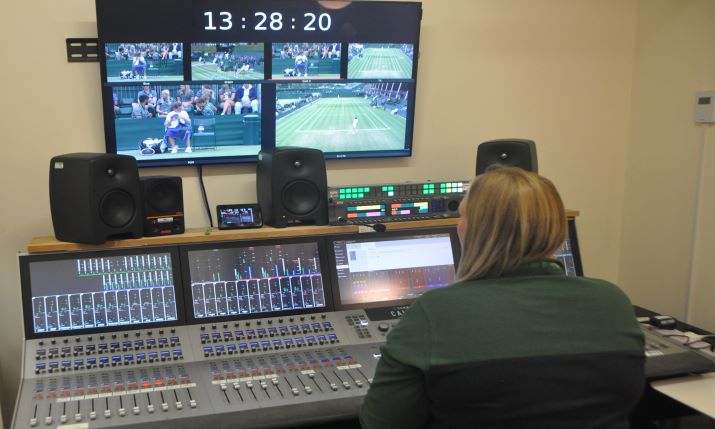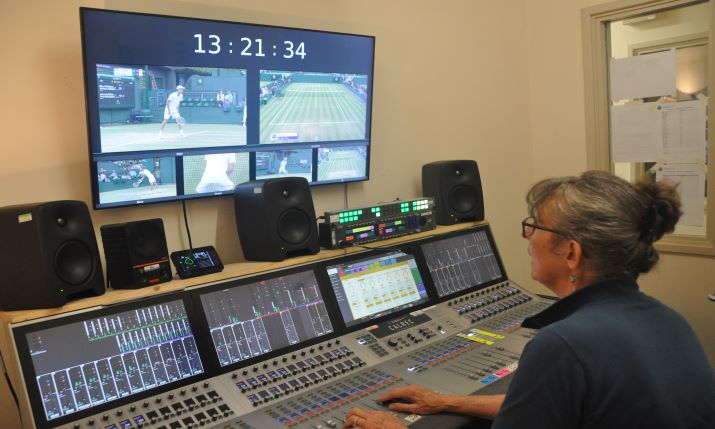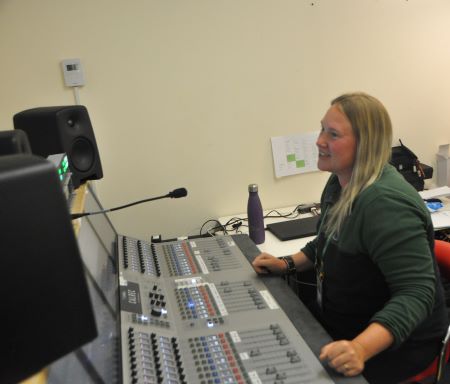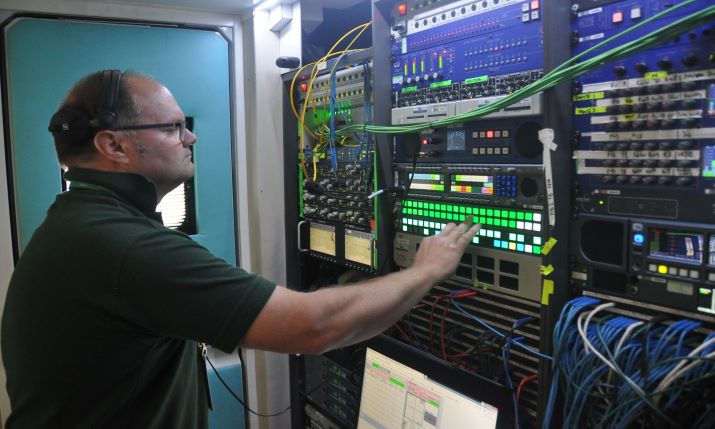Game, set and match: NEP audio production at Wimbledon 2022 boosted by strong team led by women

Sophie Lambert, freelance audio engineer, is working as the A2 on court 15 at The Championships this year
NEP is once again providing Wimbledon Broadcast Services (WBS) with technical services across the All England Lawn Tennis Club (AELTC) Championships this year, and its audio crew is being led from the front by women.
This year NEP is also doing BBC Sport’s unilateral coverage, which it did previously from 2014 to 2018, when Arena won the contract. Following Arena’s collapse, NEP is fulfilling the contract this year and then it will go out to tender for The Championships.
“We’ve had a number of women working with us over the years and we always look to recruit the best people, regardless of sex, creed, race; we just want a good, strong team, and that’s what we’ve always done in our sound department”
Comments Neville Hooper, deputy head of sound at NEP UK: “We have around 60 sound crew operating on site across the WBS contract, providing host coverage, interviews and press conferences via the interview rooms, as well as Wimbledon Uncovered and the world feed operation.
“Of these, Lynn Munro is mixing Centre Court, Nicola Pollard is mixing No. 1 Court, Louise Willcox is a relief outside courts mixer, Caroline Brampton is mixing the world feed show, Sophie Lambert is A2 on Court 15, and Andria Sjoberg is A2 on Court 16.
“In addition, of the four A2’s on the BBC domestic coverage that we are providing this year, we have Jo Salisbury and Judith Healey on the crew, both of whom we have worked with for many years.”

Lynn Munro is mixing Centre Court for NEP at Wimbledon
Recruiting the best people
Hooper adds: “There’s a good number of women working on site, and we always try and include them when they’re available. Often they’re in demand and they’re hard to get a hold of, which is certainly something we found. We’ve had a number of women working with us over the years and we always look to recruit the best people, regardless of sex, creed, race; we just want a good, strong team, and that’s what we’ve always done in our sound department. We are just keen to be inclusive and just get the best people involved.”
“Trying to get a consistent 5.1 audio design across all of the courts is not impossible, but very hard. We spend a lot of time talking about the esoterics of where to put microphones”
There are several women in audio working on site at Wimbledon outside of NEP’s crew, including Caroline Brampton, broadcast sound supervisor, audio engineer and operator, who is mixing the world feed for NEP, and Ruth Parfitt, freelance sound engineer, for Warner Bros. Discovery working with Gravity Media.
On the number of women at Wimbledon working in audio, Louise Willcox, relief sound supervisor at Wimbledon working for NEP during the event and freelance sound supervisor, says: “We’re getting more prevalent, let’s put it that way. In the broadcast community, generally, if you’re looking at the number of sound supervisors who exist in the UK, you’re probably only talking about a cohort of about 150 people. It’s not surprising we all meet each other. And hopefully, we’re bringing on new talent as we go. There’s not been that much proper training gone on over the years, but we do try and pass on our skills where we can.”
Tennis audio challenges
On what the key challenges are for Willcox on this Wimbledon in particular, she notes: “The challenge at Wimbledon always is that all of the courts, with the exception of Centre and No. 1, are different in shape and size, and size of audience [watching live matches]. Trying to get a consistent 5.1 audio design across all of the courts is not impossible, but very hard.
“We spend a lot of time talking about the esoterics of where to put microphones for the rears, the centre, the stereo across the front, commentary, and trying to manage the acoustics,” Willcox goes on. “So that’s one of the biggest challenges; it’s just such a large set of courts. Making something that’s acceptable [quality] for all of the [rights holders], who just want a consistent audio picture of audience behind you and to the sides and action in front of you, sometimes that’s not quite as easy to produce here because it’s such a quirky location.”
“The nice thing is that I’ve been able to sit in [with an A1] and mix for a little while, under the guidance of the guys who are doing the mixing, which is an opportunity that doesn’t come along very often”
Willcox states: “Here we are mixing sound on Courts 3, 8, 12, 14, 15, 16, 17, 18, Centre, No. 1 and No. 2, obviously. The Centre, 1 and 2 Courts we’re treating slightly more prestigiously, because they are the bigger show. There are sound mixers associated with each of those.
“Last year, there were three and this year there are six relief sound supervisors, increased numbers to cope with, I think, the fact that there is a playing on Sunday this year that there hasn’t been in previous years, and also, I suspect, as COVID ‘spares’. We have had a few people go sick, fortunately not in sound supervisor roles.
“I’m one of the six sound supervisors allocated to mix in any of those courts, to give people two meal reliefs per day,” Willcox continues. “And where we can, we’re trying to make sure people don’t do more than 12 hour days. So some of us turn up late and finish late, some start early and finish early, to make sure everybody gets a reasonable lifestyle and can actually get home on time.”
Willcox has also taken on the role of scheduling those meal breaks for the entire audio team, which is no mean feat. “I stupidly took on the role of scheduling those breaks, which has not been easy. But I’m quite a dab hand with a spreadsheet, so myself and Hannah Gay, who is the NEP scheduler, have been liaising about who’s where.”
“I spent a day doing a schedule [before we began working on site], and I’m now up to issue five [of the schedule], which we’ve been modifying as people have been asking for stuff whilst I’m here, and also compensating for long days and so forth,” says Wilcox.

Louise Willcox, relief sound supervisor at Wimbledon working for NEP during the event and freelance sound supervisor, says women are getting more prevalent in audio at Wimbledon
Bringing in young blood
Sophie Lambert, audio assistant at Wimbledon for NEP, and also a freelance audio engineer, says: “I’m working as part of the outside court engineering team and I’m looking after two of the courts – 15 and four – so I make sure that all the microphones that are rigged for everything that we need across the two courts are good, and liaise with the sound supervisor to make sure that it’s good all the way through the day.”
Lambert did three rig days the week before the event, then had the weekend off before the tournament started. “Now we work every day all the way through,” she says. “It’s a long flog!”
She adds that it is going well so far: “It’s been good but a little bit rainy. When it rains, we all end up running around, covering our microphones up to protect them.”
Notes Lambert: “I’m so used to being one of the very few [women on crew] that it’s always nice when there’s more ladies around. And I think the legacy that BBC brings [to productions helps], because they actually did have a decent number of women in audio [when they were host broadcaster prior to 2018], so you see those faces return [as freelancers] as well. [NEP] brings in the people that know the event, that have done it a thousand times before! And then there’s people like me; this is my first time here. But I’ve worked with most of the people who are here in other situations; there’s only a limited pool of people [available in audio] and broadcast is absolutely mental at the moment. There’s more work than people.”

Sophie Lambert is enjoying her first Wimbledon and is also learning new skills on the job
On how she is finding her first Wimbledon, Lambert says: “It’s lovely. I’m staying with friends, so I’m cycling to and from work, which makes a massive difference to my mental and physical health, which you don’t get very often on jobs. So I’ve done quite a lot of tennis this year out in America and Rome. In America, you have to drive everywhere. The days are very long on tennis because it’s not like a football match that ends after two hours; we are here for at least 12 hours, usually a bit longer. So long days, but a lovely environment to work in, so it’s a trade off.”
While the audio assistants are on standby during their shifts at Wimbledon, some of them are able to get some training from the A1’s on site. Lambert has been making the most of these opportunities, she says. “The nice thing is that I’ve been able to sit in [with an A1] and mix for a little while, under the guidance of the guys who are doing the mixing, which is an opportunity that doesn’t come along very often.
“We are on standby the whole time to fix stuff or, if it chucks it down to go sort the mics out, but inbetween that time, there is opportunity for learning as well, which is really nice. I’m sat in the room with the sound supervisor who’s looking after my courts and we talk about [what he’s doing] and I’ve watched what he’s doing. I’ve had a look at the desk and I’m quite happy now to sit in whilst he’s not sat in the chair.”
Immense Championships project
The NEP guarantee engineers – freelance and staff – are on site at Wimbledon for three weeks beforehand to set up all the technical areas, which includes putting in loud speaker monitoring, picture monitoring, and all the circuitry infrastructure.
“Obviously, there’s a certain amount of infrastructure built into the broadcast centre here, but all of the extraneous stuff, it takes ages; I’m astonished at how long,” comments Willcox. “When I first arrived five years ago I couldn’t believe the immensity of the project. So they are here for at least a month beforehand, and I know that the guys who plan it usually spend about six to eight weeks with their heads in the project because, of course, every year it changes slightly.”
On the audio rig for the Championships, Hooper comments: “Because it’s built completely from scratch every year here at Wimbledon, the core facilities start to arrive three weeks before the Champs. That gets built and it’s that kind of chicken and egg situation; certain bits have to get built before the rest can get added in. So they build the core, the router, and all the consoles, and all of that goes in, and then the mics and commentary positions going out on court as the last step of that.”
Centre Court and No. 1 Court use essentially the same mic plot, with a Soundfield, a Sennheiser MKH 8050/ATE 308 on both the north and south wall, an MKH 416 on both the near and far snoops as well as on the near and far argue all around the umpire’s chair, a Sony ECM 77 net mic, plus an MKH 8070 on each of the cameras on the opposite side of the court from the umpire. Meanwhile Court 2 and the rest lose the Soundfield and utilise combinations of Sennheiser MKH 418 M/s mics and 8050 Cardioid mics.
Hooper comments on the audio set up for the courts: “Over the 18 courts, every court or pair of courts has a dedicated mixer. There are 11 court mixing consoles covering the 18 courts. Then there are A2’s who look after the commentary and the effects mics and that kind of thing, and there’s a core team of engineers as well.
“So there’s two mixers in trucks, so Centre and No. 1 are still mixed in traditional trucks, and are done as an OB, feeding into the main system. There’s seven separate control rooms, basically dealing with the other courts. Because some of the courts are automated – Tr-ACE courts we call them (referencing NEP Fletcher’s robotic camera technology with motion tracking) – they’re done in a different way. But the main, bigger show courts are still done with a separate vision mixer and EVS operators and all of that, and that’s incorporated into the Broadcast Centre in Wimbledon.”
Lambert comments: “The rig is absolutely epic here. I worked on the Jubilee and the NEP trucks literally rolled from the Jubilee straight to here, so it’s absolutely epic in terms of the engineering. I wasn’t part of the rig crew; I came in for the last couple of days during the testing phase rather than the building phase.”
She comments on the set up on her courts: “So we have an array at one end of the court; when you’re watching tennis, you’ve always got camera one that’s at the centre, at the back, so you can see how it’s played. Like in football you have camera one which follows the ball; it’s exactly the same idea. So there, we have an array which is designed to cover the whole of the court, so we get all the ball sounds from that when the ball hits the back of the boards and stuff like that.
“You also get a bit of crowd from that as well,” she continues. ” The outside courts don’t have massive crowds, so we are really concentrating on capturing the sound of tennis. That then goes off to [whichever rights holder has] paid for that particular match and they will put their own commentary on the top of it. So we are just providing them a base on which to build the rest of the show.
“Then we’ve got a couple more mics, which are on the umpire chair. When they do the coin toss, we try our best to get a bit of that [from those mics] and sometimes those mics might give us a little bit of access to those arguments with the umpire. When you move up to Centre, No. 1 and No. 2 Courts, there’s more microphones to pick up more and more things, whereas the outside courts are paired down because smaller matches happen there,” continues Lambert.

Neville Hooper, deputy head of sound at NEP UK, hard at work at Wimbledon 2022
Solid sound infrastructure
Since NEP took on the contract for technical services for Wimbledon Broadcast Services in 2018 when it became the host broadcaster, audio has been done in 5.1 for all 18 courts. It also created a decentralised route node system, delivering third party rights holder feeds directly to their location, rather than all being collected from a central point in the broadcast centre.
Hooper says, “we built a large Calrec network, probably the largest one that gets built for events of this kind, so all the consoles are networked together so we can share resource, and it gives us flexibility in rooting within the system”. He adds: “The core of the decentralised router is [SMPTE] 2110.”
“Previously you’d have to have a technical operations centre (TOC), everyone would have to pull their cables through the broadcast centre to you to collect their feeds in a central place, and that would involve a lot of effort. The way it’s done now with 2110 is we have nodes from the router that are distributed to all the rights holding broadcasters using built-in fibre infrastructure, and then their feeds are enabled on that node. It also helps with WBS because they can improve their management; they issue us with the booking form and basically tell us what feeds people have booked, so what we’re able to provide to the third party broadcasters.
Read more Live from Wimbledon 2022 – AELTC’s Paul Davies on balancing innovation and tradition
“So it improves the infrastructure, but it also cuts down on people’s time and the mess within the broadcast centre of everyone having pull cables through and all of that. All of that has gone, so that was a big step forward,” he says.
Since 2018 all the commentary units onsite have been Dante, “and any commentary unit can be switched into any gallery, so there’s redundancy built in, so that it’s a very flexible set up,” notes Hooper. “There’s a lot of fibre infrastructure; there’s very little copper used here. A lot of the stuff is over fibre, be it hydra boxes from the consoles or infernos over fibre. And then for the host operation, we’ve reached somewhere in the region of 150 telex panels for the various operational positions, so it’s quite a large intercom operation for this.”
NEP’s contract with Wimbledon has been renewed for another four years, so we can expect to hear more high quality sound for years to come.
The AELTC Championship runs until 10 July 2022
